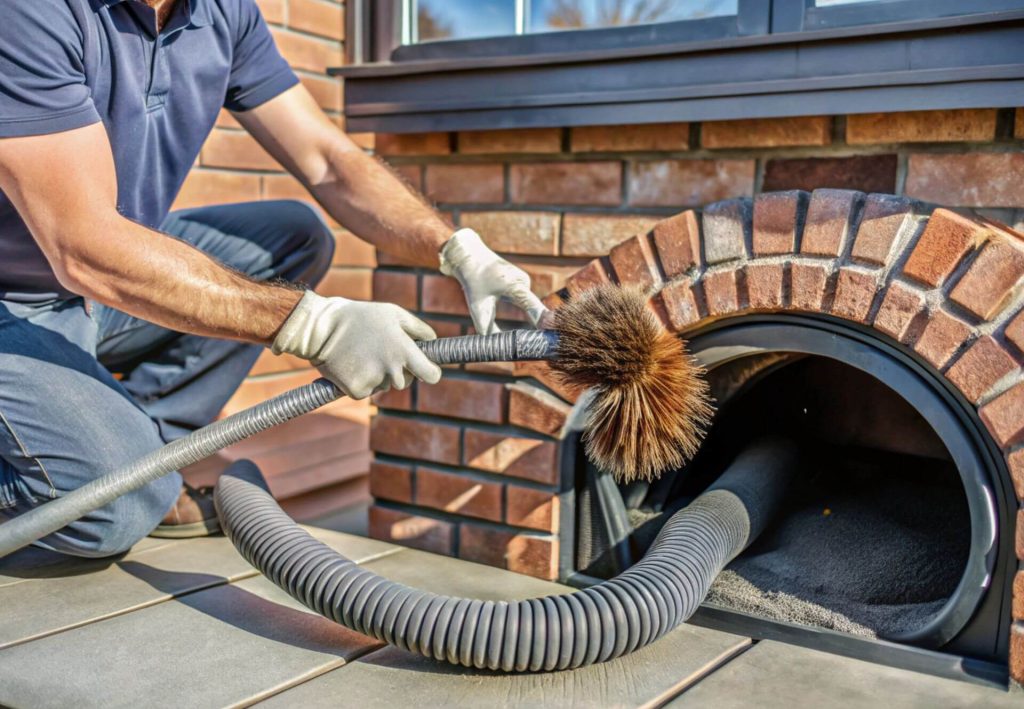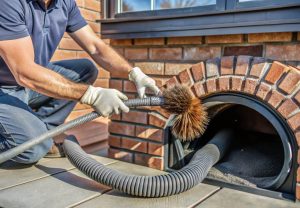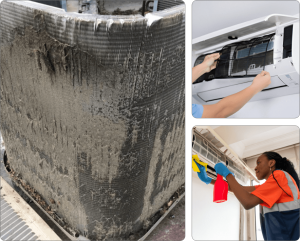Most people never think about their chimney height until something goes wrong. Like smoke backing up into the house, and or failing an inspection. Or worse, a fire hazard nobody noticed. There’s a rule called the 3-2-10 rule. And if you own a home with a chimney in NYC, you need to understand this for your betterment.
The 3-2-10 rule tells you how tall your chimney needs to be above your roof. It’s a safety code that’s been around for decades. And it exists for good reasons.
Here’s what the numbers mean.
- 3 feet: Your chimney has to stick up at least 3 feet above the spot where it comes through your roof. That’s measured from the high side of where it penetrates the roof.
- 2 feet: The top of your chimney needs to be at least 2 feet higher than anything within a 10-foot radius. That includes other parts of your roof, walls, or structures nearby.
- 10 feet: This is the distance you measure horizontally from your chimney in all directions.
So basically, if you draw a circle 10 feet around your chimney, the chimney top needs to be 2 feet taller than anything inside that circle. And it always has to be at least 3 feet above the roof.
Why Does This Matter?
Two big reasons. Safety and performance.
When your chimney isn’t tall enough, sparks and flames can reach your roof. Imagine a chimney fire. If burning creosote shoots out the top and your chimney is too short, that stuff can land on your shingles. Your roof catches fire. Your whole house is now in danger. The other reason is the draft. Your chimney needs proper height to create good draft. That’s what pulls smoke up and out of your house instead of back into your living room.
A chimney that’s too short might not draft properly. You’ll get smoke in your house. Your fireplace or wood stove won’t burn right. You’ll think something’s wrong with your appliance when really, it’s the chimney height.
During any professional chimney installation in NJ, contractors have to follow this rule. It’s not optional. It’s part of building codes.
How Steep Roofs Change Things
Here’s where people get confused. The steeper your roof, the taller your chimney often needs to be.
Let’s say your chimney comes through your roof 6 feet away from the peak. And you’ve got a pretty steep roof. That roof keeps rising as it goes toward the peak. So even though you’re within that 10-foot circle, the peak of your roof might be higher than you think. You have to calculate how much higher that peak is within 10 feet of your chimney. Then add 2 feet to that. For example, if your roof rises 4 inches for every 12 inches of horizontal distance, and your peak is 6 feet away, you need to do some math. Six feet times 4 inches equals 24 inches of rise. Add the required 2 feet, and your chimney needs to be 4 feet above where it goes through the roof.
See what we mean? It gets complicated fast.
That’s why when people are planning chimney installation in NJ, they usually bring in professionals who know how to measure this stuff correctly. One mistake and you’re not up to code.
What Happens If You Don’t Follow The Rule
Some people think, “My chimney’s been like this for years. It’s fine.”
Just because your chimney was built a certain way 30 years ago doesn’t mean it meets current code. If you’re selling your house, a home inspector will check this. If your chimney doesn’t meet the 3-2-10 rule, that’s going to show up in the inspection report. Buyers might walk away. Or demand you fix it before closing. If you’re doing any work on your chimney like installing a new liner or connecting a new appliance, you’ll have to bring the whole thing up to code. That includes height.
And if there’s ever a fire and investigators find your chimney wasn’t up to code? Your insurance company might have questions. Uncomfortable questions.
Common Problems People Miss
A lot of chimneys out there don’t meet the 3-2-10 rule. More than you’d think.
Sometimes it’s because of additions. You add a second story to your house. Now, your chimney, which was plenty tall enough, is suddenly too short compared to the new roofline. Sometimes it’s because of nearby structures. You build a dormer. Or add a deck roof. Now you’ve got a structure within 10 feet of your chimney, and the chimney isn’t 2 feet higher than it. Sometimes it’s just bad original construction. The builder eyeballed it instead of measuring properly. Or they didn’t understand the rule. Or they tried to save money by using less chimney pipe.
When contractors do proper chimney installation in NJ, they account for all of this from the start. They measure twice. They check the math. They make sure everything meets code before the work is done.
Wind And Other Factors
Taller chimneys in windy areas might need extra bracing. If your chimney sticks up more than 5 feet above your roof, it’s exposed to wind. That creates stress on the structure. You might need support brackets. Or guy wires. Something to keep that tall chimney stable during storms.
And if you live at a high elevation, the draft can be affected. Some places need chimneys even taller than the minimum to work properly. These are things professionals think about during chimney installation in NJ projects. They look at your specific situation. Your roof pitch. Your location. Wind exposure. All of it.
DIY Vs Professional Installation
Some people love DIY projects. And there’s nothing wrong with that for a lot of home improvements.
But chimneys? This is one area where professionalism is a must.
- First, there’s the safety aspect. Working on a roof is dangerous. Especially when you’re hauling heavy chimney sections up there.
- Second, there’s the code compliance. If you don’t know how to properly measure and calculate the 3-2-10 rule, you’ll get it wrong. Then you’re stuck with a chimney that doesn’t meet code.
- Third, there’s liability. If you install it yourself and something goes wrong, you’re on the hook. No warranty. No insurance backing. Just you and the problem.
Professional chimney installation comes with proper permits, inspections, warranties, insurance. Someone who knows the local codes inside and out.
You get it done right the first time instead of having to redo it later.
The Cost Of Getting It Wrong
Let’s talk about money for a second. Because this matters.
Say you ignore the 3-2-10 rule. Your chimney’s too short. You think it’s fine. Then you go to sell your house. The home inspector flags it. Now you’ve got three choices. Lower your selling price to account for the problem. Pay to fix it before closing. Or lose the buyer and start over with someone else.
Fixing a too-short chimney after the fact costs way more than doing it right initially. You might need to add sections. Maybe install new flashing. Possibly repair roof damage. All while trying to close on a house sale.
Or worse, you have a chimney fire. Your insurance investigates. They found the chimney wasn’t up to code. Now you’re fighting with your insurance company while your house has fire damage. Compare that to just doing it right from the start. Yes, proper installation costs money. But it costs less than fixing problems later.
What You Should Do
- If you’re building new or replacing a chimney, work with pros who know the 3-2-10 rule inside and out. Ask them to show you their calculations. Make sure they’re pulling permits and getting inspections.
- If you have an existing chimney, get it inspected. A certified chimney sweep company can tell you if your chimney meets current height requirements. They can measure it properly and let you know if there are issues.
- If your chimney is too short, you have options. Sometimes you can add sections to increase height. Sometimes you need more extensive work. But at least you’ll know what you’re dealing with.
- Don’t wait until you’re trying to sell the house. Don’t wait until smoke backs up into your living room. Don’t wait until there’s a fire.
The 3-2-10 rule exists to protect you and your family. It’s not arbitrary. It’s based on decades of understanding how chimneys work and what goes wrong when they’re not built right.
Get Your Chimney Right
Chimney height isn’t exactly exciting; rather, it’s one of those things hiding in plain sight that you never think about until there’s a problem.
But now you know. Three feet above the roof. Two feet higher than anything within 10 feet. That’s the minimum. Not a suggestion. Not a maybe. The actual requirement. Are you confident your chimney meets this standard? Do you even know how tall it is compared to your roofline? If you’re in New Jersey and you need a new chimney or have questions about your existing one, don’t guess. Don’t assume. Get someone who knows what they’re doing.
At Alpha Clean Air, we’ve done countless chimney projects. We know the 3-2-10 rule like the back of our hands. We measure properly. We calculate correctly. And we make sure every chimney installation in NJ we do meets or exceeds code requirements.
Because your family’s safety isn’t something to mess around with. Neither is your home’s value, nor your ability to use your fireplace without smoke backing up into your house. How much longer are you going to wonder if your chimney is safe and up to code? Call us to ensure your chimney is doing its job the right way.





